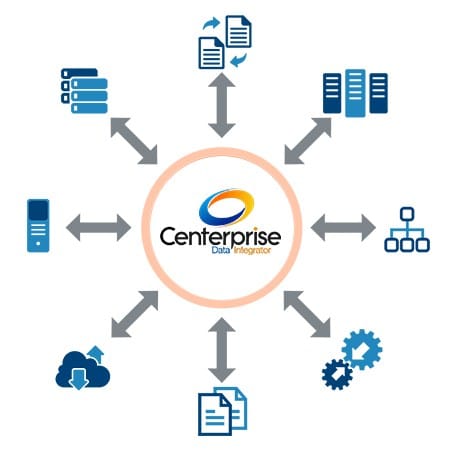Cloud integration has become more popular as the use of Software as a Service (SaaS) solutions continues to grow. IDC predicts this growth will continue and the global SaaS market is expected to reach $220.21 billion at a CAGR of 13.1% through 2022.
Moreover, an increasing number of businesses are operating with a hybrid mix of SaaS and on-premises applications, creating a greater need for progressive integration methods. In this article, we’ll take a look at what cloud data integration is and how it can benefit your business.
What is cloud data integration?
Cloud data integration comprises tools and technologies that connect various applications, systems, repositories, and IT environments. It allows the real-time exchange of data and processes. Once unified, the data and integrated cloud services can then be accessed by several devices over a network or via the internet.

Centerprise cloud data integrator. Source: Astera
At its core, the process of cloud integration centers around configuring many application programs to “talk to each other” or share data in the cloud. In an aptly integrated cloud platform, several onsite (non-cloud) and cloud-based applications can communicate directly or via 3rd party software.
Benefits of cloud data integration
Businesses that use cloud integration have synchronized data and applications, enhancing their ability to operate effectively and easily. Other benefits include:
1. Legacy to cloud integration
Cloud data integration can help companies address their integration challenges by using a hybrid cloud environment to connect legacy systems and cloud-based applications through APIs.
In this case, you can keep your legacy systems running, while extracting data from them without sacrificing reliability, performance, or security. Your business processes will keep running without disruption, but you’ll be able to communicate with both your internal and external stakeholders in real-time.
2. Scalability and future-proofing
With a cloud data integration platform, you can effectively integrate all new technologies as your business grows and matures. As the cloud offers scalability and compatibility with all modern applications, you don’t have to go through a major migration when moving to the cloud. This future-proofs your business and saves costs in the long run.
3. Improved operational efficiency
Cloud integration allows you to have quick and consistent data synchronization, which also eliminates redundant data and enhances operational efficiency. By integrating data and services, your company will have all the required systems to automatically implement many similar tasks that can be performed and edited at any time, and anywhere.
4. Increased competitive edge
When your employees can access, edit, and share data anytime, from anywhere, they can achieve more together, and perform better. Transitioning to the cloud gives your company and workers better access to enterprise-class technology. It allows smaller businesses to think clearly and act faster than the bigger, more established businesses.
Cloud integration also helps improve customer satisfaction. The ability to immediately access real-time data enables transparency between the business and its customers. Sharing the most up-to-date information will instill the assurance of a well-run company.
5. Reduced operational costs
Cloud data integration allows the organization to cut operational costs. Decreasing the number of users that keep the software running, and the need for specialized and expensive talent to administer integration will reduce the total cost of ownership.
Cloud-based solutions don’t require the hefty upfront investment of on-site solutions and there are also reduced maintenance costs. Upgrades and annual license fees come with the package, while energy usage is also minimized as there’s no longer energy-expensive hardware to power on-site.
Purpose of cloud data integration
Cloud data integration should no longer be considered a ‘nice to have’ option. It’s an important resource and a crucial element of your operation. But why do you really need cloud data integration? Here are the few possible uses:
Break down data silos
Cloud integration can help you break down data silos that occur when data is stored in a way that makes it unreadable or inaccessible by data tools. The presence of data silos means that your teams have limited visibility of the info in the organization.
When your employees only see part of the broader picture, they will miss out on opportunities to work together toward common goals or extract the full value of data that has already been collected.
Optimize business processes
Within a business, sharing information across applications is significant. However, without seamless, real-time access to data from other networks and applications, that process is not possible.
Cloud data integration provides access to accurate data in real-time so that you can optimize business processes.
Unify information components
Cloud data integration helps you consolidate all your information components. This consolidation can normalize the data and provide access to advanced data insights.
For example, marketing data can be aggregated and presented with a unified view, then exported into business intelligence tools. By unifying your information components, all critical data can be at your fingertips. Having data all in a single place enhances productivity and efficiency.
Improve connectivity and visibility
Another important purpose of using cloud data integration is to improve connectivity and visibility. An integrated enterprise ensures the ability to maintain high performance in today’s times of relative uncertainty, urgency, and potential disruptions. The better your company’s integration, the better your ability to adapt to whatever variations and innovations occur in the business world of the future.
For example, when import and export tariffs or supply levels inevitably change, companies with visibility into that change can quickly react and limit its effects downstream. Integrated systems and applications ensure there are no surprises from one system to another.
Getting Started with Cloud Data Integration
Astera Centerprise is a powerful enterprise-grade data integration tool that bridges the gap between raw data and business insights. You can use it to easily integrate data from internal and external sources, as well as automate data exchange with business partners. You can build data pipelines in a code-free environment.
Astera Centerprise features a large number of built-in connectors for both modern and traditional data sources. You can integrate data from a wide range of sources including CSV, Excel, or fixed-length files, relational databases, hierarchical EDI and XML files, legacy formats, enterprise applications, cloud solutions, and data warehouses.







